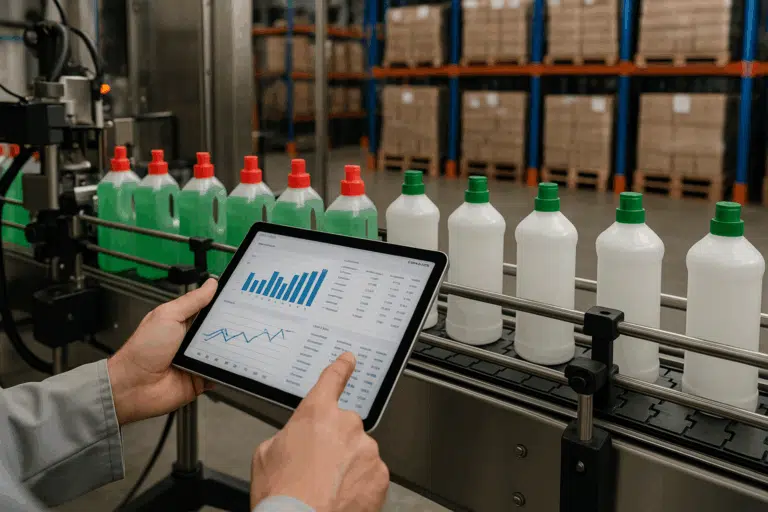In today’s fast-paced business landscape, supply chain management plays a crucial role in determining the success of an organization. Efficiently managing inventory and ensuring stock visibility are critical factors that can significantly impact the bottom line. This is where Radio Frequency Identification (RFID) technology comes into play, offering unprecedented possibilities for businesses to optimize their supply chain operations.
Table of Contents
ToggleWhat is RFID technology?
RFID is a wireless technology that utilizes radio waves to automatically identify and track objects or assets. It consists of tags or labels attached to items, which contain electronically stored information. These tags can be read remotely by RFID readers or scanners, allowing for seamless and real-time data collection.
How does RFID enable total stock visibility?
RFID technology enables total stock visibility by providing accurate, real-time data on inventory levels throughout the supply chain. Here’s how it works:
RFID Tags
Each item or product in the supply chain is affixed with an RFID tag. These tags contain electronically stored information, including a unique identifier for each item.
RFID Readers
RFID readers or scanners are placed at various checkpoints within the supply chain, such as warehouses, distribution centers, and retail stores. These readers emit radio waves that activate and read the information stored in the RFID tags.
Automated Data Capture
As items pass within the range of RFID readers, the tags are automatically detected and their data is captured. Unlike barcodes, RFID tags can be read without requiring line-of-sight or direct scanning, allowing for faster and more efficient data collection.
Real-time Data Updates
The captured data from RFID tags is instantly transmitted to a centralized inventory management system or database. This system records the movement of each item in real-time, providing up-to-date information on stock levels, location, and other relevant details.
Continuous Inventory and Stock Tracking
With RFID technology, stock visibility is not limited to periodic manual checks. Instead, the inventory system is continuously updated as goods flow through the supply chain. This ensures that businesses have real-time information on stock availability and can accurately track the movement of items.
Data Integration and Analytics
The data collected from RFID tags can be integrated with other systems, such as enterprise resource planning (ERP) software, to provide a holistic view of the supply chain. Advanced analytics can be applied to this data to gain insights into demand patterns, identify trends, optimize inventory levels, and make data-driven decisions.
By leveraging RFID technology, businesses can eliminate manual inventory counts, reduce errors, and have immediate access to accurate stock information. This enables them to optimize stock replenishment, respond quickly to changes in demand, prevent stockouts or overstocks, and improve overall supply chain efficiency. Ultimately, RFID enables total stock visibility by providing real-time data capture and continuous monitoring of inventory levels throughout the supply chain.
How can RFID technology reduce labor costs in the supply chain?
Since RFID’s are a new and more high tech scanners, one of its main goals is to offer substantial benefits for you and you company by reducing labor costs within the supply chain through automation and increased efficiency:
- Automation:
- RFID tags attached to products, cases, or pallets allow for automated data capture without requiring manual scanning. This eliminates labor-intensive scanning processes and enables seamless tracking and identification of items as they pass through RFID readers along the supply chain.
- Inventory Management:
- Real-time and accurate inventory tracking provided by RFID eliminates the need for manual counting and inventory checks. This reduces labor costs associated with physical inventory counts and reconciliations, freeing up resources for more value-added tasks.
- Supply Chain Visibility:
- RFID provides real-time visibility into the movement of goods, enabling improved planning, forecasting, and decision-making. By automating data collection, analysis, and reporting, RFID reduces labor costs related to manual data entry, reconciliation, and report generation.
- Order Fulfillment:
- RFID technology speeds up and enhances order picking and fulfillment processes by ensuring faster and more accurate identification and verification of items. This minimizes errors and reduces the time spent searching for specific products, leading to lower labor costs associated with order errors, rework, and customer service inquiries.
- Receiving and Shipping:
- RFID simplifies receiving and shipping processes by automating data capture and verification. It eliminates manual data entry, barcode scanning, and paperwork, reducing errors and saving time. Streamlined processes result in reduced labor costs related to manual data handling and documentation.
How can RFID data be utilized for demand forecasting and supply chain optimization?
RFID (Radio Frequency Identification) data can be effectively utilized for demand forecasting and supply chain optimization by providing real-time and accurate information about the movement of goods. Here’s how RFID data can be leveraged:
- Real-Time Inventory Visibility:
- RFID enables continuous and real-time tracking of inventory as it moves through the supply chain. By capturing data on the location and quantity of items in real-time, RFID provides an up-to-date and accurate picture of inventory levels. This visibility allows for more precise demand forecasting, as it eliminates delays and discrepancies often associated with manual data entry or batch-based updates.
- Enhanced Demand Sensing:
- RFID data provides granular information about individual products or items, allowing for better demand sensing capabilities. By analyzing RFID data, such as item movement, shelf availability, and customer interactions, businesses can identify patterns and trends in consumer behavior. This helps in understanding demand patterns, detecting changes in buying patterns, and responding quickly to fluctuations in demand.
- Improved Supply Chain Visibility:
- RFID enhances overall supply chain visibility by capturing data at various stages of the supply chain, including manufacturing, warehousing, and transportation. This data can be integrated with other systems, such as enterprise resource planning (ERP) and demand management systems, to gain end-to-end visibility. With a comprehensive view of the supply chain, businesses can make informed decisions regarding production planning, inventory allocation, and logistics optimization.
- Demand-Driven Replenishment:
- RFID data enables demand-driven replenishment, where inventory is automatically replenished based on real-time demand signals. By monitoring RFID data on product availability, businesses can proactively initiate replenishment activities, minimizing stockouts and reducing excess inventory. This approach optimizes inventory levels, reduces holding costs, and ensures timely order fulfillment.
- Supply Chain Optimization:
- Leveraging RFID data for supply chain optimization involves analyzing and optimizing various aspects of the supply chain, such as transportation routes, warehouse operations, and order fulfillment processes. RFID data provides visibility into the movement of goods, enabling businesses to identify bottlenecks, streamline processes, and make data-driven decisions to improve overall efficiency and reduce costs.
Where to start if you think RFID can help
RFID technology holds immense promise for unlocking total stock visibility and transforming supply chain operations. Its ability to provide accurate, real-time data on inventory levels, enhance traceability, and optimize operational efficiency makes it a valuable tool for businesses aiming to stay competitive in today’s dynamic market.
As organizations continue to explore the possibilities of RFID, we can expect to see even greater advancements in supply chain management, leading to improved productivity, reduced costs, and enhanced customer satisfaction.
The most appropriate place to start is to reevaluate those business processes and internal controls you wish could be automated. By integrating RFIDs with ERP (or WMS) Systems, firms can scan their inventories faster and more accurately – while relying less on manual resources – to provide real-time inventory insights, which allows the organization to significantly increase shipping accuracy
Our Supply Chain Advisory team has deep experience in reviewing and establishing inventory management and tracking programs using advanced technology (RFIDs) for internal controls and regulatory compliance.
Contact us today to learn more.



























